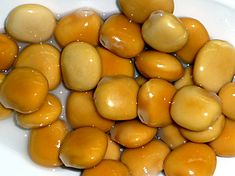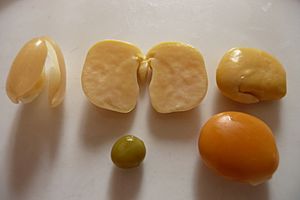Lupin bean facts for kids

Pickled lupini beans ready for consumption
|
|
| Nutritional value per 100 g (3.5 oz) | |
|---|---|
|
9.88g
|
|
| Dietary fiber | 2.8 g |
|
2.92 g
|
|
| Saturated | 0.346 g |
| Trans | 0 |
| Monounsaturated | 1.180 g |
| Polyunsaturated | 0.730 |
|
Protein
|
15.57 g
|
| Vitamins | Quantity
%DV†
|
| Thiamine (B1) |
12%
0.134 mg |
| Riboflavin (B2) |
4%
0.053 mg |
| Niacin (B3) |
3%
0.459 mg |
| Vitamin C |
1%
1.1 mg |
| Vitamin D |
0%
0 μg |
| Minerals | Quantity
%DV†
|
| Calcium |
5%
51 mg |
| Iron |
9%
1.20 mg |
| Magnesium |
15%
54 mg |
| Phosphorus |
18%
128 mg |
| Potassium |
8%
245 mg |
| Sodium |
0%
4 mg |
| Zinc |
15%
1.38 mg |
| Other constituents | Quantity |
| Water | 71.08 |
|
USDA
|
|
| †Percentages estimated using US recommendations for adults. | |
Lupin or lupini beans are the yellow seeds of the Lupinus plant. They are a type of legume, like peas or lentils. People often eat them as a pickled snack. You can find them in the Mediterranean region, Latin America, and North Africa.
Lupins have been around for a very long time. The oldest proof of their use comes from ancient Egypt. This evidence dates back to about 2200 BCE. Some lupin beans are naturally bitter because they contain substances called alkaloids. These bitter beans need to be rinsed carefully before eating. However, there are also "sweet lupins." These types have been specially grown to have very few bitter alkaloids. Lupin beans are becoming a popular plant-based protein source worldwide.
Contents
A Brief History of Lupins
When Did People Start Using Lupins?
The first records of lupins come from ancient Egypt. Seeds of a domesticated lupin plant were found in the tombs of Egyptian Pharaohs. These tombs belonged to the Twelfth Dynasty, around 2200 BCE. This shows that people in the Mediterranean were using lupins a very long time ago.
Where Are Lupins Popular Today?
Lupins are very popular in Egypt. They are known as "termes" there. Egyptians often eat them as a snack during the Sham el-Nessim festival. This festival is a national holiday with roots in ancient Egyptian times.
The Romans also loved lupini beans. They helped spread lupin farming across their empire. Today, you can find lupini beans in Mediterranean countries. This includes places like Spain, Portugal, and Greece. They are also popular in Brazil and across the Middle East.
Lupins in the Americas
In the Andes Mountains of South America, people grew a different kind of lupin. This was Lupinus mutabilis. People living in what is now Peru domesticated this bean before the Inca Empire. Pictures of lupin seeds and leaves from around 600-700 BCE are in a museum in Lima. This shows lupins were a common food during the Incan Empire. Native Americans in North America, like the Yavapai people, also used lupins.
Different Types of Lupin Beans
Some lupin types are called "sweet lupins." This is because they have much less of the bitter, toxic substances called alkaloids. "Bitter lupin" types have more alkaloids. New types of narrow-leafed lupins, like the 'Australian Sweet Lupin', are grown in Australia, Germany, and Poland. These don't taste bitter and don't need to be soaked in salt water.
How Are Sweet Lupins Used?
Sweet lupin seeds are used to make many foods. These include lupin flakes, vegan sausages, lupin-tofu, and lupin flour. Lupin seeds have all the essential amino acids your body needs. Unlike soy, lupins can grow in cooler places. This makes them a great alternative crop to soy.
Farmers also grow three Mediterranean lupin species for animal feed. These are blue lupin, white lupin, and yellow lupin. However, bitter lupins can make livestock sick if not prepared correctly.
Growing Lupins Safely
Lupins are grown widely in Australia, Europe, Russia, and the Americas. They are used to improve soil, feed animals, and as a high-protein food for people. In Australia, farmers are careful to prevent bitter and sweet lupins from mixing. They keep a wide area around lupin farms. This stops wild bitter pollen from affecting the sweet lupin crops.
Lupins in the Kitchen
Popular Lupin Snacks
In Egypt, lupin is called "termes." Street vendors and markets sell it as a very popular snack. It's especially enjoyed during the Sham el-Nessim festival.
The Andean lupin (L. mutabilis) and the Mediterranean white lupin (Lupinus albus) must be soaked. People soak the seeds for several days in salted water to make them safe to eat. In Ecuador, lupin is often eaten as a street food called "cevichochos." It's similar to ceviche.
How to Eat Lupini Beans
Lupini beans are often sold in jars, soaked in salty water. They are like olives or pickles. You can eat them by making a small tear in the skin with your teeth. Then, you "pop" the seed into your mouth. You can also eat them with the skin on. Or, you can remove the skin by rubbing the bean between your fingers. In Portugal, "tremoços" are a popular snack in bars, especially when people are drinking beer.
Lupin Flour and Other Uses
Lupin beans can be ground into a flour. This flour is often added to wheat flour in parts of Europe and Australia. It makes foods taste better and gives them a rich, creamy color.
Lupins can also be a main ingredient in vegan meat and dairy substitutes. In 2020, only a small amount of lupins were eaten by humans. Most were used as animal feed. But lupin beans are becoming more popular as a plant-based protein source around the world.
What's Inside Lupin Beans?
Lupins are unique because they don't have starch. This is unusual for an edible bean. Lupin beans have a thick outer layer called a seed coat. This coat is mostly cellulose fiber and is removed first during processing. The inner part of the lupin bean is rich in protein (40%) and fiber (40%). It also has a moderate amount of fat (8%), mostly healthy unsaturated fats. Modern lupin plants have been bred to have very low levels of the bitter alkaloids.
Lupins also contain good amounts of carotenoids. These include beta carotene, lutein, and zeaxanthin. They also have tocopherols, which are a form of vitamin E. Australian sweet lupins have more calcium and phosphate than cereals. The amount of other minerals depends on the soil where they grow. Lupin oils have strong antioxidant properties, partly due to their vitamin E content.
Important Safety Information About Lupins
Understanding Lupin Toxicity
Lupin poisoning is a problem caused by alkaloids in bitter lupins. It affects people who eat lupin beans that haven't been prepared correctly. Some cultures prefer bitter lupins for their flavor. But these beans must be soaked in water to remove the toxins. If bitter lupins are not soaked enough, too many alkaloids can remain. This can lead to poisoning symptoms.
The alkaloids in raw, dried beans are very bitter. Soaking reduces this bitterness and the amount of alkaloids. There are medical reports of people getting sick from mistakes in preparing lupini.
Symptoms of Lupin Poisoning
Symptoms of lupin bean poisoning can include:
- Large pupils that don't react to light
- Feeling confused or disoriented
- Slowed thinking
- A flushed face or fever
- A fast heart rate and high blood pressure
- Tremors (shaking)
- Difficulty speaking or slurred speech
- Problems with coordination
- Dizziness
- A burning, dry mouth
- Stomach pain
- Feeling anxious or generally unwell
Experts recommend that consumers avoid bitter lupin seeds that haven't been prepared by a manufacturer. This is because it's hard to know if home soaking methods remove enough of the harmful alkaloids.
Lupinosis Disease
There's also a disease called Mycotoxic lupinosis. This happens when lupin plants are infected with a fungus called Diaporthe toxica. This fungus makes toxins called phomopsins, which can cause liver damage.
Lupin Allergy
Some people can have a serious allergic reaction to lupin. This reaction can be life-threatening, called anaphylaxis. Lupin allergy is sometimes linked to peanut allergy. This means people with peanut allergies should be very careful with foods containing lupin.
Lupin in Food Products
In the EU, food labels must list lupin as an allergen if it's in pre-packed foods. However, it might be hidden in foods sold over-the-counter. This can be a big problem for people with allergies. Lupin can be found in breads, pastries, pizzas, pasta, cakes, and even ice cream. It has also been found in some tomato ketchup sauces.
Right now, there are no treatments to make someone less sensitive to lupin. The best advice is to avoid foods with lupin. People with severe allergies should also carry an epi-pen and anti-allergy medicine.


